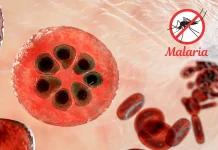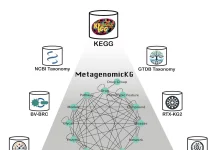Typhoid, once a disease that ravaged countries, had been considered tamed by the introduction of new antibiotics in the mid-20th century. Awareness of the importance of sanitation and hygiene also rose as literacy and higher education rates increased; however, the rise of multidrug resistance in various typhoid strains has become a cause for concern. A new consortium, the Global Typhoid Genomics Consortium, has now been formed to further our understanding of antimicrobial resistance in typhoid in different countries and regions. Enabling policymakers to make decisions utilizing genomic data from disease surveillance may make it easier to plan for disease outbreaks and treatment.
Salmonella Typhi, commonly referred to as Typhi, is the causative agent of typhoid fever, which, if left untreated, can be fatal, with mortality ratios estimated to be less than 1% in modern times but ranging from 10% to 20% in the pre-antibiotic era. Historically, the disease has been responsible for deaths on a mass scale, usually triggered by the prevalence of unhygienic conditions, as urbanization and industrialization led to overcrowded cities and unsafe living environments. While the situation has mostly improved in many parts of the world due to significant improvements in water, sanitation, and hygiene infrastructure, it is still responsible for more than 10 million infections, as well as more than 100,000 deaths annually. A large number of these deaths were in low-income countries, with patients often having less access to clean water, food, and hygiene infrastructure.
Salmonella was one of the initial pathogens to undergo sequencing in high-income countries. Public health laboratories often identify Typhi strains from patients and carriers, which serves as an informal method for monitoring the genetic makeup of pathogenic populations in countries with a high prevalence of the disease. More recently, whole genome sequencing (WGS) was utilized for disease surveillance in both endemic and non-endemic countries.
The increasing resistance to available treatments necessitates tracking antimicrobial-resistant (AMR) Typhi to find its emergence and likelihood of spreading. This kind of tracking is crucial for guiding the production of important data that can be used to prevent failure of treatments and directing the implementation of preventive measures such as typhoid conjugate vaccines (TCVs) as well as improved WASH awareness and support.
Due to the abundance of WGS data for Typhi, a system that enhances the visibility as well as the accessibility of genomic data is crucial. To achieve this, the Global Typhoid Genomics Consortium (GTGC) has been formed in order to collaborate with the broader research community. The collection of genomic data and standardized metadata will enable the discovery of important insights that can guide the creation of public health policies.
A large dataset of 13,000 Typhi genomes has now been presented. This dataset provides an overview of the diversity present in Typhi and its resistant variants. Sequence data from over 20 years of sequencing efforts was collected, including currently unpublished data, all listed by isolation location and year. Analysis was conducted using Illumina readings and assembled using an assembly pipeline from the Centre for Genomic Pathogen Surveillance. All assemblies were uploaded, and phylogenetic trees for the sequences were constructed utilizing Pathogenwatch. AMR and genotype frequencies were then calculated for all countries and world regions. Data visualizations were also performed for the data in order to generate easily accessible and understandable plots.
More than 10,000 genomes were used and recorded for the same; predominantly, these datasets originate from South Asia and other typhoid-endemic regions. It was seen that certain genotypes, which are found primarily in Asia as well as East and Southern Africa, were not present in large numbers in other regions of Africa, in Central and South America, or Melanesia and Polynesia. Countries in North America, Australia, New Zealand, and Europe are considered to no longer be endemic for typhoid, and most infections discovered are generally assumed to be associated with travel to other regions.
More than 6000 genomes were reported from South Asia, showing a prevalence of the H58 genetic lineage in the region, though its distribution may differ by country. Different countries were also dominated by different sublineages; sublineage 2, for example, was prevalent in Nepal and India but was exceedingly rare in Bangladesh and Pakistan. H58 also accounted for more than 47% of infections originating in South-East Asia, as well as in West Asia, where it is considered to be largely travel-associated.
Only about 1400 genomes were recorded from Africa, with there being a severe underrepresentation of genomic data from the continent. Interestingly, it was found that H58 in East Africa was dominant, and in Kenya, it had been introduced in three separate times, with all of them having been assigned different genotypes. Country-level differences did exist, with different genotypes dominating in different countries.
In West Africa, much of the data recorded was from the TSAP program, with the most frequent genotypes being 3.1.1 and 2.3.2, with the former dominating in Ghana, Burkina Faso, and Nigeria, and the latter in Gambia, Senegal, and Guinea Bissau. These patterns have been long established in the region and are also reflected in data from Nigerian surveillance as well as from travel-associated infections. Central America was also dominated by 2.3.2, with most genomes originating from Guatemala, Mexico, and El Salvador. In South America, 105 genomes were recorded, with more than 92% being from Chile due to the occurrence of a surveillance study in 2022. These genotypes were very diverse, and there was no dominant genotype found.
The prevalence of resistance to various drugs for genomes of different regions was also found, with Ciprofloxacin resistance being found in more than 10% of the genomes in South Asian countries and 3-6% of genomes originating from South Africa, Mexico, and Chile. Multidrug resistance was found to be on the decline in India, Nepal, and Bangladesh but has risen in Pakistan. Incidences have also remained high in Eastern African countries but have declined in Nigeria. It was noted that a difference in fitness costs may account for this divergence in incidence, depending on whether the resistance was chromosomally encoded or borne through plasmids. Extensively drug-resistant sublineages were recognized in Pakistan, especially in the Sindh province. Azithromycin resistance-associated genes were found in 74 genomes, primarily in Bangladeshi and Indian genomes, though these were rare.
Conclusion
The creation of the GTGC, almost 20 years after the first-ever sequencing of Typhi was performed, provides an accessible and easy-to-use platform where data on Typhi can be accessed. The presentation and accessibility of data on Typhi can be crucial to developing new strategies for managing disease outbreaks, as well as recommended treatments. Depending upon the incidence of various lineages, different countries may choose to invest in the production of different treatments and will have the ability to make data-driven decisions regarding medical infrastructure and disease surveillance.
Article source: Reference Paper
Learn More:
Sonal Keni is a consulting scientific writing intern at CBIRT. She is pursuing a BTech in Biotechnology from the Manipal Institute of Technology. Her academic journey has been driven by a profound fascination for the intricate world of biology, and she is particularly drawn to computational biology and oncology. She also enjoys reading and painting in her free time.
















